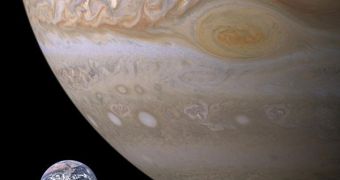Data collected between 1996 and 2006 seems to prove that one of Jupiter's most prominent features, its Great Red Spot (GRS), a colossal storm with a diameter twice that of the Earth, is shrinking at a slow speed. Other supermassive weather disturbances have already appeared to challenge its status on the planet. The GRS has been wrecking havoc in Jupiter's atmosphere for more than 300 years, but it could be older. Unlike terrestrial atmospheric events, this type of occurences on the planet can last for years, or even several centuries.
Jupiter is apparently going through a period of climate change as well, which could be the cause of this happening. But there are other explanations for why the GRS is shrinking as well, including the fact that, like any storm, it can “feed” on clouds it comes across. However, if it can do that, it can also be tore apart by other such events that take place right outside its borders. Smaller weather occurrences can literally rip off pieces of the larger tempest and make them their own, or annihilate them altogether.
By using more than a decade's worth of atmospheric readings and wind pattern data, scientists have now been able to conclude that the GRS is, indeed, shrinking. “The velocity data show that the Red Spot has been shrinking along its major diameter by about 15 percent over that period,” University of California in Berkeley (UCB) astronomy expert Xylar Asay-Davis, the leader of the new study detailing the find, explains. Researchers Phil Marcus, Mike Wong and Imke de Pader have also contributed to the research.
“Velocity is a more robust measurement because the clouds associated with the Red Spot are also strongly influenced by numerous other phenomena in the surrounding atmosphere. We find that the Red Spot has been shrinking but not slowing down,” Asay-Davis adds. “We don't fully understand all the sources of energy, or the ways the Red Spot loses energy, but these can become slightly imbalanced for a period of time, and this is likely to be what is causing the Red Spot to shrink – less energy is being fed in and more is slowly dissipating away,” he tells Space.
“The south pole may be getting colder, while the equator gets a bit warmer. The recent upheaval may have been Jupiter's way of adjusting or compensating for this climate change. Eventually, we may see new vortices form that will mix up the heat again. We hope that we can continue to produce wind field maps of Jupiter so as to keep monitoring the climate in the years and decades to come,” the scientist concludes.

 14 DAY TRIAL //
14 DAY TRIAL //